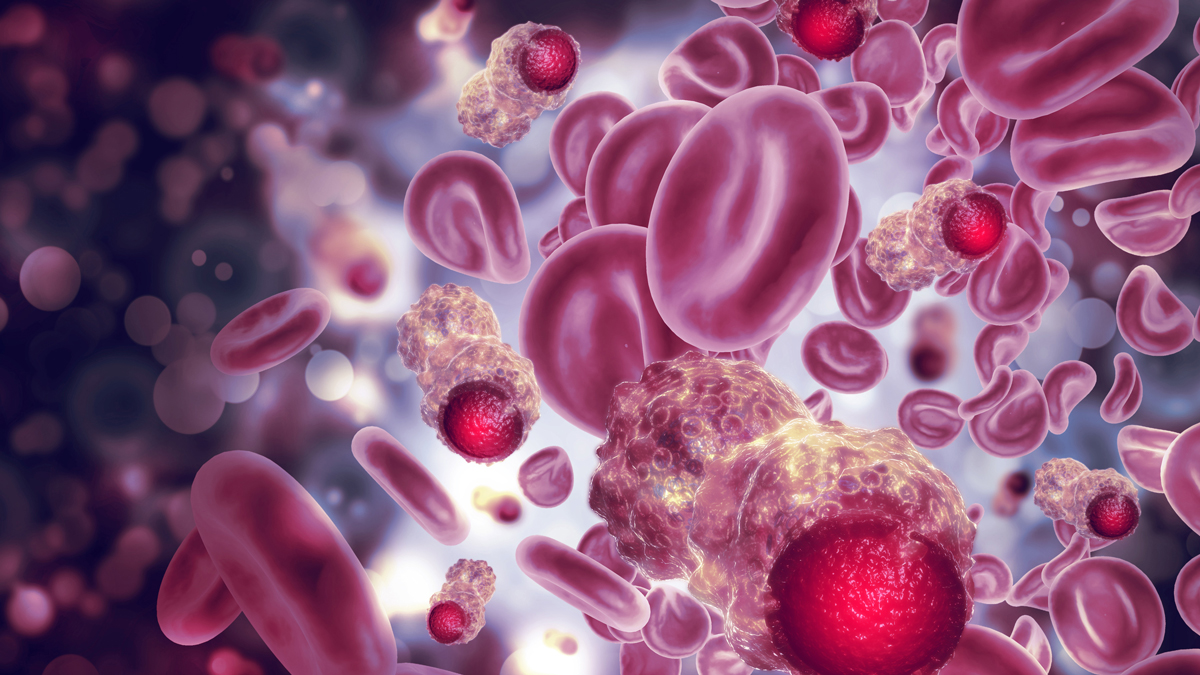A history of blood cancer treatment

Despite being one of the most common forms of cancer, awareness of blood cancer pales in comparison to other types of the disease. In fact, according to Blood Cancer UK research, more than half of UK adults cannot name a single symptom of blood cancer.
Over the past two centuries, researchers have identified more than 100 different types of blood cancer, while most patients may be familiar with the big three (leukaemia, lymphoma, and melanoma). However, myelodysplastic syndromes and myeloproliferative neoplasms are also prominent types of blood cancer.
Thanks to the dedicated efforts of doctors, patients, carers, and healthcare professionals, people diagnosed with blood cancer are now living longer, with a steady stream of more effective treatments entering the market each year. However, there is still much to be done to achieve a vision wherein all those diagnosed with blood cancer survive.
As we enter Blood Cancer Awareness month, a global event dedicated to spotlighting and supporting efforts to improve awareness, detection, and treatment of blood cancer, we take a look back in celebration of the achievements and breakthroughs that paved the way for today’s innovations.
1832 – Discovery of Hodgkin’s and non-Hodgkin’s lymphoma
Although early accounts of an illness akin to leukaemia can be traced back to Ancient Greece, the first official description of blood cancer didn’t appear until 1832, when British pathologist and pioneer of preventative medicine Thomas Hodgkin used the controversial concept of micrology to identify the abnormalities in the lymphatic system.
During his time working in the pathology museum at Guy’s Hospital in London, Hodgkin studied several preserved specimens of human organs affected by disease. Noticing a pattern in the lymph nodes and spleen that indicated the appearance of disease, he published his findings in a paper entitled, ‘On Some Morbid Appearances of the Absorbent Glands and Spleen’.
At the time, his hypothesis appeared to fall on deaf ears, and it would take a further three decades before Hodgkin's discovery was recognised.
1844 - First reported case of multiple myeloma
The first well-documented case of multiple myeloma was reported in 1844 by renowned British surgeon Samuel Solly. In 39-year-old patient Sarah Newbury, Solly observed the appearance of fatigue and bone pain resulting from multiple fractures. Only four years after the patient first showed symptoms, she died, and an autopsy revealed abnormalities in the bone marrow that closely matched the autopsy findings of 45-year-old Thomas Alexander McBean.
McBean's case is perhaps the most well-known account of multiple myeloma. Similar to Newbury, McBean – known to be a highly respected tradesman – developed fatigue and severe pain from weak and easily broken bones. After attempts to treat McBean's symptoms - through cupping, applying leeches for maintenance therapy, and therapeutic phlebotomy - proved unsuccessful, his physician, Dr Thomas Watson, prescribed steel and quinine, while a sample of his urine was sent to chemical pathologist Henry Bence Jones.
Following his death in 1846, histologic examination of McBean's bone marrow revealed a red gelatiniform substance consisting of nucleated cells, some twice the size of an average blood cell.
1847 – Virchow links tumours and white blood cells
By the 1840s, histology (the study of microscopic anatomy) was a recognised discipline in the scientific community. Building upon early descriptions of leukaemia by French anatomist and surgeon Alfred-Armand-Louis-Marie Velpeau, in 1847, "the father of modern pathology" Dr Rudolf Virchow and English physician John Hughes Bennett independently observed abnormal increases in white blood cells in patients.
Virchow was the first to argue that cancer derives from changes in normal cells. Crucially, he observed a connection between certain tumours and inflammation, noting that neoplastic tissues were often covered with leukocytes of the immune system.
As with Hodgkin's discovery, Virchow's theory went almost unnoticed until the 20th century.
1907 – The magic bullet of immunotherapy
In the early 1900s, researchers uncovered the existence of several types of blood cancer. However, effective treatments were not available at the time. During this period, Nobel prize-winning German scientist Paul Ehrlich developed his lock-key hypothesis of molecules that specifically bind to cell receptors.
Further research led Ehrlich to develop his side-chain theory, that antibodies produced by white blood cells act as receptors on the cell membrane. For his contribution, in 1908, Ehrlich received the Nobel Prize for Medicine in the field of immunology, together with the "father of innate immunity", Ilia Metschnikow, whose discovery of phagocytosis formed the foundation of cell-mediated immunity.
While they may not have known it at the time, through their work Ehrlich and Metschnikow formed the cornerstone of modern immunology, including chemoreceptor and chemotherapy concepts that revolutionised blood cancer treatment over the following century.
1942 – Chemotherapy moves from trenches to treatment
In the aftermath of World War I, medical researchers noticed that the mustard gas used to make chemical weapons for the battlefield also destroyed lymphatic tissue. Early experiments showed that topically applying nitrogen mustard caused tumours to shrink in mice.
Research into the medical potential of mustard gas stagnated until 1942, when two assistant professors at Yale, Louis S Goodman and Alfred Gilman, began to study the effects of nitrogen mustard on lymphoma. Although clinical trials proved that chemicals could be used to treat cancer, the results of the study remained a closely guarded military secret until 1946.
1956 – The rise of bone marrow transplants
In a milestone achievement for blood cancer research and treatment, Dr E Donnall Thomas performed the first successful bone marrow transplant in 1956. The procedure involved transplanting bone marrow between identical twins, with tissue taken from the healthy twin given to the other who had leukaemia.
In 1968, the first bone marrow transplant using a matched donor took place at the University of Minnesota. Using a blood test developed by Dr Fritz Bach, Dr Robert Good determined that the patient, a baby with a severe immune deficiency, was a human leukocyte antigen match with his nine-year-old sister.
The ground-breaking approach to donor selection paved the way for future bone marrow transplants, including the first successful bone marrow transplant with unrelated patients in 1973.
Before the birth of bone marrow transplants, patients were often treated using chemotherapy, which could be used to kill cancer cells. However, this also presented a problem: chemotherapy does not discriminate between healthy and cancer cells, meaning that if patients were given sufficient doses to kill the disease, normal cells would also be harmed. With the advent of bone marrow transplantation, these healthy cells could be replaced with donor cells, allowing for higher doses of chemotherapy in treatment.
1980s – Emergence of cord blood transplants
Another source of haematological stem cells emerged in the late 80s – cord blood stem cells. The remaining blood found within the umbilical cord and placenta after birth is rich in blood-producing stem cells. Cord blood collection has rarely changed since the first successful procedure occurred in 1988.
Stem cells extracted from a donated cord can be frozen for a number of years and quickly accessed when needed. Once the transplant is complete, the cells will travel into the patient's bone marrow, where they will begin to grow into normal blood cells.
Recognising the need to identify and match potential donors with patients, in 1989 the Bone Marrow Donors Worldwide programme was established.
Today, the bone marrow donor registry comprises more than 39,527,166 donors and 804,246 cord blood units.
2001– FDA green lights revolutionary treatments
Innovation in blood cancer treatments ushered in a new generation of targeted and precision treatments. One such therapy was Imatinib (also known as "Gleevec" or "Glivec"), a first-generation tyrosine kinase inhibitor dubbed a 'magical bullet', designed to specifically target BCR-ABL tyrosine kinase.
Just over a decade after it was developed by biochemist Nicholas Lyndon, Imatinib received US Food and Drug Administration (FDA) approval in 2001. Since then, it has transformed the treatment of chronic myeloid leukaemia and non-Hodgkin's lymphoma.
The following year, the regulator also approved Rituximab, a monoclonal antibody targeting CD-20 positive B-cells, as a companion treatment of chemotherapy in older diffuse large B-cell lymphoma patients.
2002 – Emergence of CAR-T therapy
Building on the success of cytokine-based immunotherapies, scientists continued to seek other areas where the immune system could be leveraged against tumours. Throughout the 90s, Dr James Allison spearheaded research into T-cell engineering, a revolutionary technique that formed the foundation of chimeric antigen receptor (CAR) T-cell therapy.
Dr Allison's research into the function and application of T-cells in cancer treatment greatly broadened scientific understanding of the immune system. However, the first generation of CAR T-cells proved to be clinically ineffective.
It wasn't until 2002, when Memorial Sloane Kettering Cancer Center scientists Michel Sadelain, Renier Brentjens, and Isabelle Rivière opted to push the boundaries of research, by genetically engineering T-cells with a CAR, that the technique achieved successful results.
This research paved the way for the first successful treatment of a patient with acute lymphoblastic leukaemia in 2011.
2012 – The 100,000 Genomics Project begins
Unlocking the secrets of the human genome has intrigued investigators for centuries. However, the technology needed to analyse genomic and long-term clinical data is a relatively recent development. With the launch of the 100,000 Genomes Project in 2012, an international team of researchers studied the role that genes play in health and disease.
For the first time, researchers demonstrated that whole genome sequencing could be used to uncover new diagnoses across the broadest range of rare diseases. This was an entirely new approach to DNA research. Previously, DNA would be segmented into short sections, which would then be read and sequenced separately.
The 100,000 Genomes Project sparked a new wave of research exploring the clinical potential of sequencing long strands of individual DNA without cutting them into sections. With this technique, it is hoped that researchers will gain previously inaccessible insights into cancer, revealing more accurate diagnoses and treatment pathways for patients.
2016–2022 — New treatments enter the market
Over the past few years, the number of treatments approved for blood cancer has skyrocketed. Johnson & Johnson's Darzalex (daratumumab) was a notable development for the sector. The monoclonal antibody first received FDA approval in November 2015 as a monotherapy for patients with multiple myeloma, marking it as the first CD38-directed antibody to receive regulatory approval to treat the disease. It has since gone on to receive numerous approvals for multiple myeloma designations.
As of 2022, more than 800 new cell therapies are being developed for five blood cancers, with the market for oncology cell therapies expected to exceed $37 billion in value globally by 2028.
If you liked this story, check out the related video below.












